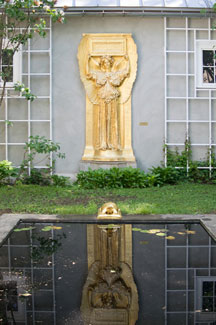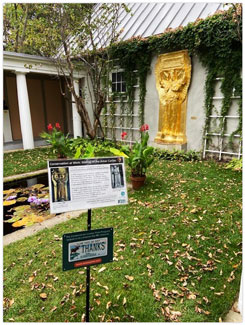 |
New Hampshire has an abundance of natural, cultural and historic resources, all of which need to be protected and preserved for future generations to continue to benefit from them. A unique program that generates funds for this conservation and preservation work is New Hampshire Conservation License Plates, also known as “Moose Plates.” The voluntary purchase of these license plates helps state agencies to support the conservation of our state’s natural, historical and cultural heritage. Since 2001, the Moose Plate program has contributed to the ongoing success of hundreds of projects across New Hampshire.
Saint-Gaudens National Historical Park applied to the NH State Council on the Arts’ Arts Conservation License Plate (“Moose Plate”) Grant program to conserve one of their most iconic sculptures, the Amor Caritas. Located in Cornish, New Hampshire, Saint-Gaudens National Historical Park preserves the home, gardens, and studios of one of America's foremost sculptors, Augustus Saint-Gaudens (1848–1907). Designed in 1885-99, the Amor Caritas is a winged female figure holding a tablet that was to be the central figure for a proposed tomb for New York Governor Edwin Morgan. During construction of the tomb, it mysteriously burned and the project was abandoned. This standing angel design was used several times after that, but the tablet’s position varied from either being raised above her head or other times being held in front of her. The Amor Caritas proved to be one of Saint-Gaudens’ best-known sculptures and has been produced in bronze, granite, and marble and in both full-size and half-size.
The Amor Caritas is located in the center of the Atrium, a three-sided, open-air gallery and garden. Last re-gilded in 1995, the gold leaf on the Amor Caritas sculpture had worn away in many places, exposing the underlying treated bronze. Although the sculpture is regularly cleaned to protect from deterioration due to age and exposure to the outdoor elements, it was critical to replace the gilded surface to protect and preserve the sculpture.
The conservation of the Amor Caritas sculpture, including two turtle sculptures at either end of the Atrium’s small reflecting pool, was completed by Robert Shure of Skylight Studios in Woburn, Massachusetts. As an accomplished artist, Shure has created many public and private monuments and sculptures. His work also includes the conservation of antique sculpture and monuments and the restoration of sculptural elements on historic buildings. For more information on the Amor Caritas sculpture and the gilding process completed by Robert Shure, please watch this video by Judy Hayward of Historic Windsor, Inc.
Photos (top to bottom):
- The Amor Caritas sculpture prior to the conservation work. Photo courtesy of Saint-Gaudens National Historical Park.
- Close up of the Amor Caritas sculpture showing the gold leaf worn away in places, exposing the underlying treated bronze. Photo courtesy of Saint-Gaudens National Historical Park.
- Close-up of the conserved Amor Caritas sculpture. Photo courtesy of NH State Council on the Arts.
- Conserved Amor Caritas sculpture and two turtle sculptures located in the Atrium Gallery. Photo courtesy of NH State Council on the Arts.
- Conserved Amor Caritas with Moose Plate Sign. Photo Courtesy of NH State Council on the Arts.

|

